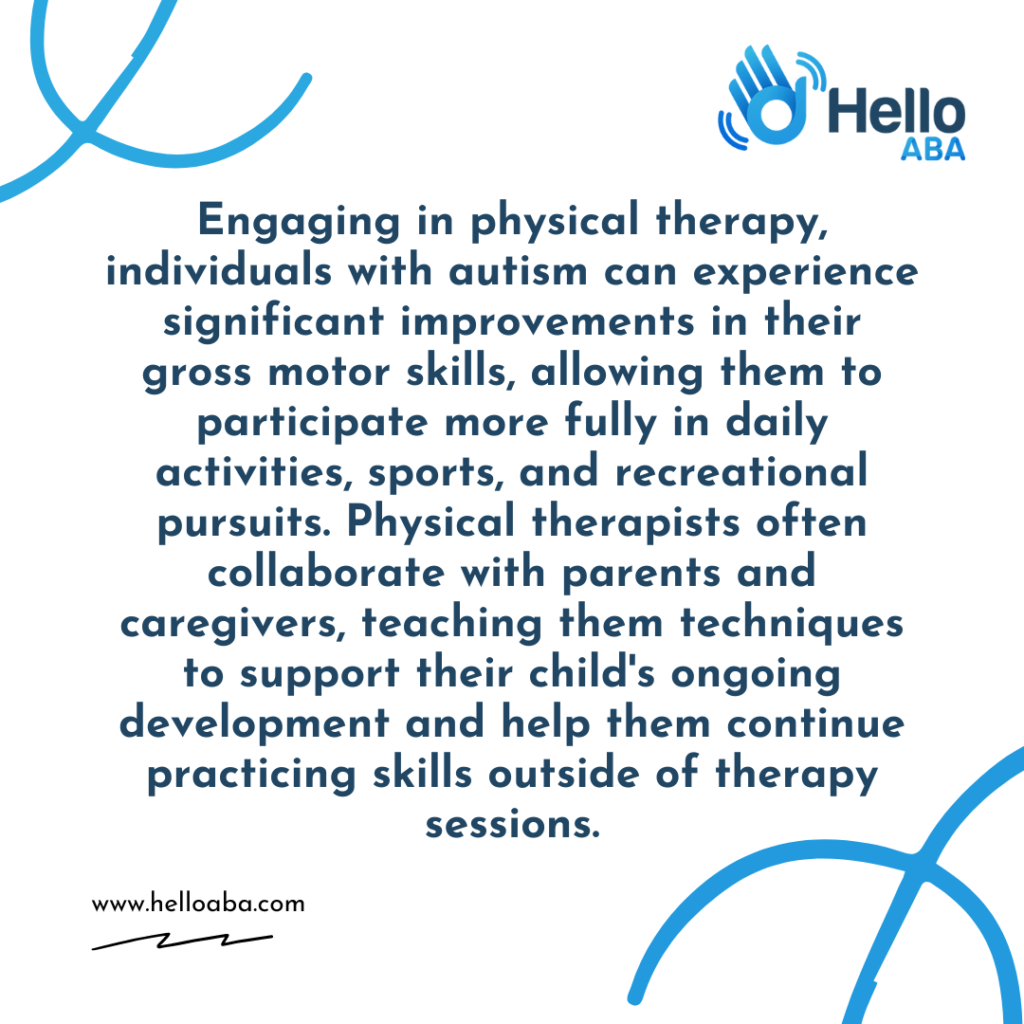Physical therapy plays a crucial role in supporting individuals with autism by addressing movement challenges and promoting overall development. Problems with movement are common in autism spectrum disorder (ASD), making physical therapy an essential intervention for many individuals with ASD.

Role of Physical Therapy
The primary goal of physical therapy for individuals with autism is to help them develop and improve their gross motor skills. Gross motor skills refer to the ability to use large muscle groups to perform activities such as walking, running, jumping, and playing. These skills are essential for everyday activities and social interactions.
Physical therapists specializing in early intervention for children with ASD, particularly those under three years of age, play a critical role in supporting the development of crawling, standing, and walking milestones. These therapists address significant delays in these areas and help children reach their motor development goals.
In addition to facilitating gross motor skill development, physical therapists also focus on improving coordination, balance, and body awareness. By targeting these areas, individuals with autism can enhance their overall movement abilities, leading to increased participation in daily activities and improved quality of life.
Physical therapists must find ways to develop and maintain motivation for children with autism during movement interventions. They use various techniques such as reinforcers and contingencies to shape the child’s focus and performance of exercise or movement skills. By incorporating motivating elements into therapy sessions, physical therapists can maximize engagement and optimize progress.
The collaborative approach in physical therapy is vital for individuals with autism. Physical therapists work closely with other healthcare professionals, educators, and caregivers to ensure a comprehensive and coordinated approach to intervention. By collaborating with caregivers, physical therapists can provide guidance and support, empowering them to continue therapeutic activities at home and in the community.
Physical therapy plays a critical role in supporting individuals with autism in their motor development and overall well-being. By addressing movement challenges and promoting the acquisition of gross motor skills, physical therapists help individuals with autism improve their physical abilities and enhance their participation in daily activities and social interactions.
Benefits of Physical Therapy for Autism
Physical therapy plays a significant role in supporting the development of individuals with autism. By focusing on improving gross motor skills, physical therapy can have numerous benefits for individuals on the autism spectrum.

Improving Gross Motor Skills
PT for children with Autism Spectrum Disorder (ASD) targets the development of gross motor skills, which are essential for everyday activities such as walking, running, playing, and completing chores. Physical therapists work closely with autistic children to enhance their basic motor skills, such as sitting, rolling, standing, and running. As children grow older, therapists assist them in acquiring more advanced skills like skipping, kicking, throwing, and catching, which are crucial for physical development and social engagement in sports and play.
The goal of physical therapy is to improve muscle strength, coordination, and gross motor skills in individuals with autism. Through targeted exercises and activities, physical therapists help children develop these skills and overcome challenges they may face. By working on motor skills, physical therapy promotes physical development, enhances mobility, and increases overall physical fitness.
Research has shown that individuals with autism can experience difficulties with coordination and postural control, making it more challenging for them to learn skills through imitation and observation. These delays in movement skills can persist throughout life. Physical therapists are trained to address these challenges and help individuals with autism develop age-appropriate movement skills, improve strength, coordination, and balance.
In addition to motor skills, physical therapy also addresses other areas of development, such as sensory integration, body awareness, and spatial orientation. By incorporating structured routines and physical boundaries into daily life, physical therapists promote positive behaviors, peer interactions, and overall physical and mental well-being.

Challenges Addressed by Physical Therapy
Motor planning deficits are common challenges faced by individuals with autism and can have both physical and neurological bases. These deficits lead to difficulties in performing sequential tasks due to inhibition of physical performance and processing delays.
Autistic individuals often experience difficulties with coordination, lack of muscular strength, and issues with balance, making activities such as riding a bike or using skates challenging. They may also struggle with “motor planning,” which affects their ability to coordinate their bodies for activities like swinging.
Research indicates that individuals with Autism Spectrum Disorder (ASD) can have limited coordination and postural control, making it harder for them to learn skills through imitation and observation. Delays in movement skills can persist throughout life for people with ASD.
Physical therapy plays a crucial role in addressing these motor planning deficits and supporting individuals with autism in developing age-appropriate movement skills. Through tailored interventions, physical therapists help individuals with autism walk safely, navigate stairs, and engage in play skills.
Furthermore, physical therapists assist in adding structure, routines, and physical boundaries into daily life to promote positive behaviors and peer interactions. It is important to note that despite the prevalence of movement problems in individuals with ASD, a significant number of them lack access to physical therapy services. Research suggests that approximately 87% of people with ASD experience movement problems, yet only about 31% receive physical therapy, and even fewer, around 13%, receive recreational therapy. Enhancing access to these services could greatly benefit individuals with autism by improving their motor skills and overall quality of life.
Developmental Milestones in Physical Therapy
Physical therapy plays a crucial role in supporting the development of individuals with autism, particularly in achieving important developmental milestones. Two key areas of focus in physical therapy for autism are early intervention and skill generalization.

Early Intervention Focus
Early intervention is essential in promoting the optimal development of children with autism. Physical therapists specializing in early intervention for children under three years of age play a critical role in supporting the development of crawling, standing, and walking milestones. These therapists address significant delays in these areas and work closely with children and their families to design individualized treatment plans.
Providing early intervention physical therapy, therapists aim to improve muscle strength, coordination, and gross motor skills. They assist children in achieving age-appropriate movement skills, such as crawling and walking. Through guided exercises and targeted interventions, physical therapists help children with autism reach their developmental milestones at the appropriate age.
Skill Generalization
Individuals with autism may require multiple repetitions of an exercise or movement before achieving independent mastery. Physical therapy provides opportunities for skill generalization, allowing individuals to transfer learned skills to new environments and situations. This generalization is key to promoting functional independence and enhancing overall motor development.
Physical therapists employ various strategies to promote skill generalization. They may develop home-based programs that allow for additional movement practice outside of therapy sessions. By incorporating structured exercises and consistent routines into daily life, individuals with autism can practice and reinforce their motor skills in familiar settings.
Furthermore, physical therapists collaborate closely with individuals and their caregivers to ensure that learned skills are generalized across different environments. This collaborative approach involves educating caregivers on how to support and facilitate skill generalization in daily activities and routines.
Focusing on early intervention and skill generalization, physical therapy plays a vital role in supporting the developmental journey of individuals with autism. Through targeted interventions and collaborative efforts, physical therapists help individuals with autism achieve their fullest potential by improving muscle strength, coordination, and gross motor skills.
Strategies in Physical Therapy for Autism
Physical therapy plays a crucial role in supporting individuals with autism in developing their movement skills and improving their physical well-being. When working with individuals on the autism spectrum, physical therapists employ various strategies to enhance engagement and facilitate skill development. Two key strategies used in physical therapy for autism are motivation techniques and repetition and mastery.

Motivation Techniques
Motivating individuals with autism to actively participate in physical therapy sessions is essential for successful outcomes. Physical therapists employ a range of techniques to foster motivation and engagement during movement interventions. This includes using reinforcers and contingencies to shape the child’s focus and performance of exercise or movement skills.
Incorporating the individual’s interests, preferences, and sensory needs, physical therapists create a motivating and enjoyable environment. This can involve using toys, music, games, or other sensory stimuli that resonate with the individual. The therapist may also utilize visual supports, such as visual schedules or social stories, to enhance understanding and engagement.
Repetition and Mastery
Repetition is key in physical therapy for individuals with autism. Many individuals with autism require numerous repetitions of an exercise or movement before achieving independent mastery. Physical therapists understand the importance of providing ample opportunities for practice and skill refinement.
To facilitate repetition and mastery, therapists may develop home programs in collaboration with parents or caregivers. These programs allow for consistent movement practice beyond the therapy sessions, helping to reinforce skills and promote generalization to new environments.
Physical therapists also employ a systematic approach to gradually increase the difficulty of exercises or movements as the individual progresses. This incremental progression helps individuals build confidence, develop strength, and enhance coordination over time.

How Physical Therapy and Aba Go Hand in Hand
Physical therapy (PT) and Applied Behavior Analysis (ABA) therapy can complement each other effectively, particularly for individuals with developmental disabilities like autism. PT focuses on enhancing physical abilities such as strength, coordination, and motor skills. It aims to improve an individual’s control over their body, which is essential for engaging in everyday activities. On the other hand, ABA therapy targets behavior modification, communication skills, and social interactions, using evidence-based techniques to reinforce positive behaviors and reduce challenging ones. When these therapies are combined, they can provide a holistic approach to an individual’s development, ensuring that physical and behavioral improvements support each other.
Collaboration between PT and ABA therapists can lead to the creation of comprehensive treatment plans that align their goals. For example, PT might work on improving a child’s fine motor skills necessary for tasks like writing or using utensils. Concurrently, ABA therapy can reinforce these skills through behavioral interventions, encouraging practice and proper usage in various contexts. Additionally, ABA techniques can motivate individuals to participate in physical activities, making PT exercises more enjoyable and effective. This integrated approach not only helps in developing essential skills but also ensures their generalization across different settings, promoting greater independence and functionality for the individual.
Hello ABA provides exceptional autism services in Maryland, ensuring personalized care and effective outcomes. Reach out to us today to schedule a consultation and discover how our expert team can help your child thrive.
Sources
- https://www.nichd.nih.gov/health/topics/autism/conditioninfo/treatments/physical-therapy
- https://www.autismparentingmagazine.com/physical-therapy-for-autism/
- https://www.verywellhealth.com/physical-therapy-as-a-treatment-for-autism-260052
- https://www.choosept.com/guide/physical-therapy-guide-autism-spectrum-disorder






